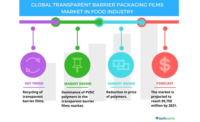Packaging Films Market- U.S.

Technology Improvements Fuel Growth in US Packaging Film Market
Growth will be driven by increased demand for more material-intensive packages that offer greater convenience and protection than traditional film formats, such as high barrier pouches. Demand will also be supported by improvements in resin technology and processing techniques, enabling low-cost production for a wider range of applications.
Food Packaging Trends Continue to Drive Gains
Food packaging represents the vast majority of demand for packaging films, accounting for 72% of the total in 2016. Increased demand for high performance, multilayer barrier films will stimulate advances across most major food markets. Producers are incorporating more layers into their film designs to extend shelf life, reduce food waste, and offer preservative free, fresher tasting foods.
Demand will also benefit from a trend toward smaller, more convenient packaging designs that facilitate on-the-go snacking and that simplify meal preparation. Re-sealable stand-up pouches, for instance, are offering significant growth opportunities in applications ranging from salty snacks to sauces.
Advanced Resin Technologies to Broaden Applications for Film in Nonfood Packaging
Pharmaceutical packaging will remain one of the fastest-growing markets in the industry as plastic film competes more effectively with the high barrier properties and chemical stability of aluminum foil. The growth of biologics -- which are more volatile than traditional oral dose drugs -- will offer significant opportunities for high barrier packages incorporating specialty resins such as COCs and fluoropolymers.
Likewise, water soluble PVOH films are growing rapidly in the chemicals market. Water soluble pods are now offered under most major dish and laundry detergent brands and are finding new use in personal care products like shaving cream.
LLDPE & PET to Post Fastest Growth of Major Resin Types
LLDPE and PET are forecast to grow at above average rates through 2021. Growth for both resins will be driven by their versatility: they are used as base resins for commodity films due to their favorable mechanical properties and relatively low cost but are also used as components of high performance barrier packages.
However, small volume, specialty resins are expected to outpace both LLDPE and PET through 2021. Particularly fast-growing resins include EVOH, bio-based plastics, fluoropolymers, and PVOH.
Study Coverage
This study presents historical demand data (2006, 2011, and 2016) and forecasts (2021) by market (meat, poultry, and seafood; snack food; baked goods; produce; dairy products; candy and confections; frozen food; grain mill products; pet food; beverages; paper and textile products; pharmaceuticals; rack and counter; medical products; agricultural and horticultural products; chemicals) and resin (LLDPE, polypropylene, LDPE, PVC, HDPE, PET, nylon, polystyrene, PVDC, EVOH, bio-based plastic). The study also evaluates company market share and offers competitive analysis on industry participants including Bemis, Sealed Air, Sigma Plastics, Berry Global, ProAmpac, Winpak, Printpack, and Inteplast.
Published: July 2017
Format: PDF emailed by publisher
Number of Pages: 191
Price: $5,300 Individual License
$7,900 Corporate License
Individual pages or sections also available
For more information and to order, Click Here
The Freedonia Group, Inc. is a leading international industry market research company that provides information and analysis needed to make informed strategic decisions for your business. Freedonia’s industry market research on Packaging covers a broad range of packaging materials (e.g., paper, plastic, metal) and applications (e.g., protective packaging, food containers). In each case various factors affecting demand are considered such as renewability, life style, distribution, end use product demand and other related issues. All studies include market size, forecasts, product and market segmentations, related economic indicator and regulatory analysis, market share estimates, a discussion of industry structure, and profiles of the leading companies.
Looking for a reprint of this article?
From high-res PDFs to custom plaques, order your copy today!






